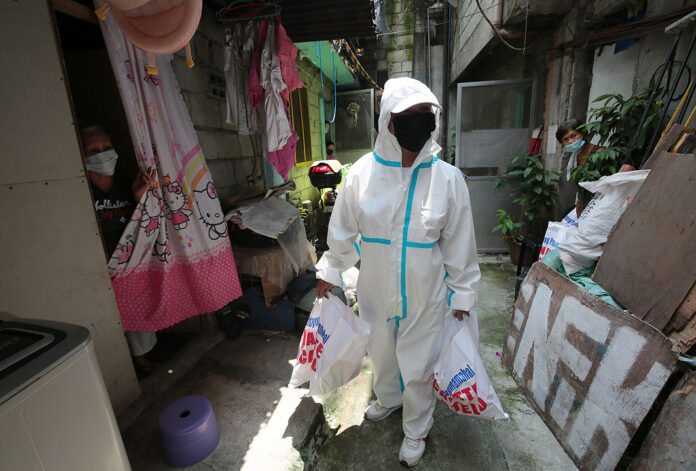RESIDENTS of a compound along Mabilis St. in the village of Pinyahan, Quezon City that was locked down due to rising COVID-19 cases received food aid on Sept. 15. — PHILIPPINE STAR/MICHAEL VARCAS
PHILIPPINE health authorities reported 16,989 coronavirus infections on Wednesday, bringing the total to 2.3 million.
The death toll rose to 35,742 after 214 patients died, while recoveries increased by 24,123 to more than two million, the Department of Health (DoH) said in a bulletin.
There were 170,446 active cases, 85.4% of which were mild, 9.8% did not show symptoms, 1.4% were severe, 2.77% were moderate and 0.7% were critical.
Forty-four duplicates had been removed from the tally, 32 of which were reclassified as recoveries and one as a death, while 135 recoveries were reclassified as deaths. Four laboratories failed to submit data on Sept. 13.
In a statement, Health Undersecretary Maria Rosario S. Vergeire said active cases in the country could reach 152,000 to 330,000 by the end of the month.
“This is not cast in stone since lower case projections are achieved when we improve adherence to minimum public health standards, reduce case detection to isolation time and increase vaccination coverage even at lower or less restrictive community quarantines,” she said.
The Philippines is set to start granular lockdowns with five alert levels in the National Capital Region on Sept. 16, as the government tries to revive the economy and curb a fresh spike in infections triggered by a more contagious Delta variant.
Metro Manila will be under Alert Level 4 — the second strictest level — until Sept. 30.
Areas under Alert Level 4, which is almost equivalent to a modified enhanced community quarantine, are those with high or increasing coronavirus transmissions and high healthcare system use rates.
Areas will be placed under Alert Level 5, equivalent to an enhanced community quarantine, only if case counts are alarming and hospital use rates reach critical” levels.
“Wide scale lockdowns might no longer be effective,” Ms. Vergeire said, noting that majority of Filipinos in the capital region were out during the strict lockdown that started on Aug. 10 since more essential activities and workers were allowed.
The presidential palace on Tuesday said the new quarantine classification is good news for workers of restaurants and other food establishments, noting that several businesses would be allowed to operate at limited capacity.
Trade Secretary Ramon M. Lopez has said some businesses, including manufacturing companies, would be allowed to operate in Metro Manila, restoring as many as 200,000 jobs.
Business groups have been pushing for a further reopening of the economy. The government earlier said economic losses averaged P73 billion for every week of a modified enhanced community quarantine in Metro Manila. Economic managers cut the full-year growth target to 4-5% to reflect the impact of strict lockdowns.
Under Alert Level 4, restaurants will be allowed to offer al fresco dine-in services at 30% capacity. Restaurants can also offer indoor dine-in services but at 10% capacity and only for fully vaccinated people.
Local government units may lower the allowed capacity for these food establishments.
Personal care services such as barbershops, hair spas, nail spas, and beauty salons will be allowed to operate at 30% capacity, but only if the services are rendered outdoors. They can operate indoors but only at 10% capacity and only for fully vaccinated people.
Workers at these establishments must be fully inoculated against the coronavirus.
Religious gatherings are also allowed but at 30% venue capacity if conducted outdoors, regardless of vaccination status, and 10% capacity if done indoors but only for those fully vaccinated. Religious leaders should also be fully vaccinated.
All other establishments or activities, except those in areas covered by granular lockdowns, may operate at full capacity provided they enforce minimum public health standards, according to the rules. — Kyle Aristophere T. Atienza

